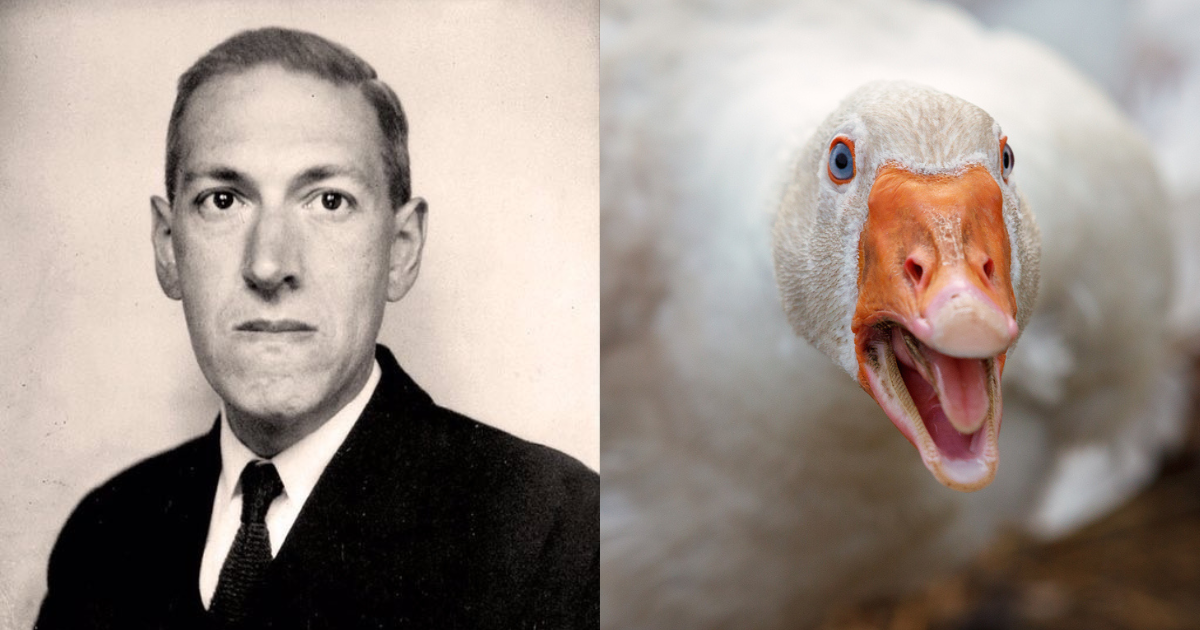H.P. Lovecraft is often recognized as one of the masters of cosmic horror, and his chilling descriptions of hideous monstrosities from outside time and space have been terrifying readers for generations. Unfortunately, Lovecraft didn’t always bring his A-game, and sometimes it was obvious that he was kind of phoning it. Here are four times H.P. Lovecraft tried to describe an unspeakable cosmic horror, but basically just described a goose.
1. “The Keening On Fenwick Pond” (1922)
In this tale, a professor of pond studies at Harvard University travels to a remote village in the Massachusetts countryside to investigate reports of a strange noise emanating from the titular Fenwick Pond. In the story’s climactic scene, the professor finally hears the noise and follows it to its horrific source in the following passage:
“How shall I describe that terrible noise that pierced the humid August air that night? It was like the honking of an automobile’s horn. An automobile driven by a murderer on his way to a fresh kill, who honks his horn as if to say, ‘Here I come! I’m on my way to kill people!’ I followed the terrible honk to the edge of the water of Fenwick Pond. What I saw there I cannot hope to ever describe. It was a THING…some sort of ENTITY. It had a long, thin neck that slithered eerily from a feathered body that bristled black and brown.
Do not ask me if the creature was married or not, for it had no hands on which to wear a wedding ring. Instead, it had wing-like appendages. Its body looked like a duck’s body, but scarier and more insane. Picture a duck and make it three–no, FOUR–times as big and you may begin to understand, in part, the shape of this monster I saw gliding along the surface of the water like some damned and demented tugboat. I felt the sanity splatter out of my mind like water from a sodden sponge thrown hard against a drug store window. I sprinted directly to the nearest insane asylum, where I remain to this day.”
Critics were quick to point out that the creature Lovecraft is describing here sounds a lot like a goose. Lovecraft refused to comment on the story, feeling that explaining his fiction too much would dilute its terrifying effect.
2. “The Thing On The Softball Field” (1925)
Lovecraft published “The Thing On The Softball Field” in the pulp magazine Weird Tales. The story centers on a professor of advanced softball studies at Brown University who travels to a softball field located deep in a secluded Rhode Island forest to witness the world’s first softball game played exclusively by men who are exactly 50 years old. Throughout the game, the professor describes hearing “a birdlike rustling in the trees,” but cannot identify the source. At the end of the game, the softball players leave the forest, refusing to let the 43-year-old professor ride back to town with them on their bus because he isn’t exactly 50 years old. As he walks back to town through the woods, he is ambushed by an abomination from beyond the stars that he describes in the following way:
“It walked upright like a man, yet it was clearly a beast. The thing’s leathery feet did not have the normal five toes that we humans have. It had FEWER than that. It had THREE toes. And yet, I hesitate to even call them ‘toes,’ for each digit was connected to each other by some sort of skin-like film. It was like some perverse spider had spun webs between each toe for some inscrutable reason known only to the mad gods that dream their furious dreams on the remotest fringes of forgotten galaxies.
On either side of the creature’s body, where its arms or tentacles should have been, there were instead wings, each covered entirely in feathers, like some horrendous inside-out pillow. I cannot hope to describe the terror that overtook me in that moment. It was like seeing one million ghosts at the same time. I fell to my knees and screamed, ‘Oh no! I’ve just gone mad and insane at the same time!’”
Several fans wrote to the editor of Weird Tales to point out that the creature with wings and three webbed toes fit the description of a goose to a tee, but Lovecraft never issued any comment on the matter.
3. “I Saw A Duck As Big As A Goose” (1929)
One of Lovecraft’s shorter stories, “I Saw A Duck As Big As A Goose” was published in Weird Tales, where it took up just a quarter of a page. The tale in its entirety reads:
“I’m a professor of theoretical madness at Dartmouth. I saw a duck as big as a goose. It laid an egg right in front of me. I ate the egg and it made me sick. Later, I went insane.”
Most readers insisted that “a duck as big as a goose” is pretty much just a goose, but Lovecraft insisted until his death that they are two different things.
4. “Those Obsidian Eyes” (1937)
This tale, first published in the pulp magazine Amazing Stories, tells the story of a professor of forbidden mathematics at Yale University. The professor travels to a 1,000-year-old library in the forests of New Haven, where it is rumored that there is a book containing a “secret version of the number six that is larger than seven and smaller than five.” The professor finds the book he was looking for, but drops it in terror when he finds himself face to face with an eldritch beast that the narrator describes in this manner:
“The creature’s neck was long and undulating, like a squid’s tentacle covered in feathers with a head on the end of it. And the head–just thinking about the thing’s head has made me five times as insane as I was when I started writing this sentence, which was already incredibly insane. The head was covered in feathers like a pigeon, but it had the flat-billed beak of a duck. A hideous chimera that resembled two different birds at once! If I were to describe the physical appearance of this creature as ‘a demented salad of grotesque avian features, dressed in a vinaigrette of malevolence,’ you would have some idea of the contours of the entity that stood before me. And in this demented salad, the vegetable that terrified me most was the eyes–those obsidian eyes! They were as black and as round as the tires of a bus. A bus that picked up commuters in Hell and dropped them off at the insane asylum.
The thing opened its duck-like beak and let out a noise that I can only describe as a ‘honk,’ though this feeble word fails to communicate the bray of malice that issued forth from that serpentine throat. I ran screaming from that cursed place. The next day, I founded an insane asylum and checked myself in as its first inmate.”
Most readers immediately identified this creature as a goose, and “Those Obsidian Eyes” is often ranked among Lovecraft’s least popular stories. Unfortunately, Lovecraft was never able to address this criticism, since he died the same day that this story was published. His literary legacy remains forever tarnished by this half-assed attempt to pass off a goose as an unspeakable cosmic horror that defies description.





